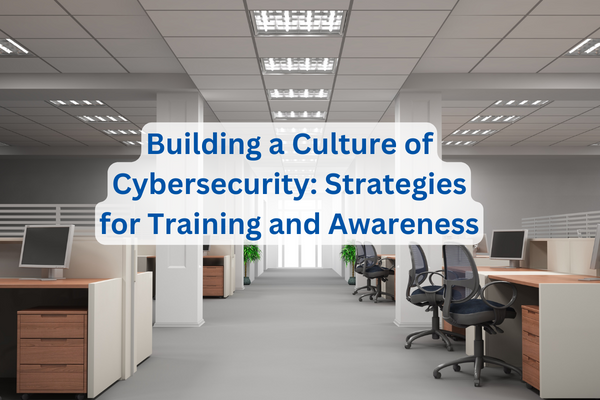Building a Culture of Cybersecurity: Strategies for Training and Awareness
Written by TJ Rubeck
In today’s rapidly evolving threat landscape, employees are often considered the weakest link in cybersecurity. Attackers often target human vulnerabilities through social engineering attacks, phishing, or other related threats. The increasing frequency and sophistication of cyber attacks have made one thing abundantly clear – organizations must build a strong culture of cybersecurity that promotes security awareness, responsibility, and accountability across employees at all levels.
Your employees act as the “human firewall”, the first line of defense against threats – they are the ones who manage the technology daily and their actions either strengthen or weaken your organization’s security posture. When properly educated, engaged, and empowered, they can be the strongest defense against cyber threats. Company culture is the foundation upon which a strong “human firewall” is built. Not only does it set the tone for how employees perceive and prioritize security in their day-to-day activities, but it also encourages employees to view security as an essential part of their role (as opposed to an afterthought).
Fostering a proactive mindset towards identifying and mitigating potential security risks is one of the surest ways to enhance the security stance at your organization. While not a complete list, I’ve shared some strategies below to help build and maintain a culture of cybersecurity:
Training and Awareness Programs: Comprehensive security training and awareness programs should be implemented to educate employees about various aspects of cybersecurity, including common cyber threats, safe browsing practices, password hygiene, email security, social engineering attacks, and incident reporting procedures. These programs should be mandatory for all employees and should be regularly updated to address new threats and vulnerabilities. Some teams may benefit from more focused training pertaining to their areas of work, but a general campaign of training and awareness is hugely beneficial to overall security.
Phishing Simulations: It is estimated that phishing is involved in nearly one-quarter of all cyberattacks and its use continues to grow each year. Conducting training and simulated phishing campaigns can help employees learn how to recognize and report suspicious emails or links before action is taken. These exercises provide valuable insights into potential vulnerabilities and areas for improvement in the organization’s security posture. Feedback and coaching should be provided to employees to help them understand their role in preventing phishing attacks. While not all organizations have the resources to create and manage a campaign of this magnitude, companies such as KnowB4 are purpose-made to introduce this training and testing into your security program.
Policies and Procedures: Clearly defined security policies and procedures (defined by leadership) should be communicated to all employees and regular reminders should be sent to reinforce their importance. Policies should cover areas such as access controls, data classification, encryption, remote access, and incident response. These policies should be an integral piece of your training and awareness programs and compliance with these policies should be monitored and enforced consistently.
Reporting and Incident Response: A strong cybersecurity culture encourages open communication and reporting of security incidents and concerns without fear of reprisal. Employees should feel comfortable promptly reporting any security incidents or concerns they observe, regardless of the details. Reporting channels and procedures should be clearly defined and easily accessible to all employees. An incident response plan should be in place to quickly detect, respond to, and mitigate security incidents.
Lastly, Leadership plays a crucial role in cultivating a culture of cybersecurity – Executives and Managers must clearly define and communicate security policies and procedures. They should lead by example, actively participate in all security initiatives, promote a positive cybersecurity culture, and continuously communicate the importance of cybersecurity to all employees. It is up to leadership to clearly define security expectations and to provide the necessary resources to support and empower their employees to be active participants in maintaining a secure environment.
Creating a Lasting Culture of Cybersecurity Awareness
A robust cybersecurity defense posture is not solely the responsibility of the IT department, it is a shared responsibility across the entire organization from entry-level to the C-Suite. By investing in comprehensive security training, implementing clear policies and procedures, conducting phishing simulations, promoting reporting and incident response, and setting the tone from the top, organizations can create a security-conscious culture that can effectively mitigate cyber risks and protect sensitive information.
Remember, cybersecurity is not a one-time effort but an ongoing process – it requires continuous education, awareness, and engagement from all employees to stay vigilant against evolving threats. Let’s work together to cultivate a culture of cybersecurity and make the human firewall the strongest defense against cyber attacks. Stay vigilant, stay secure!







